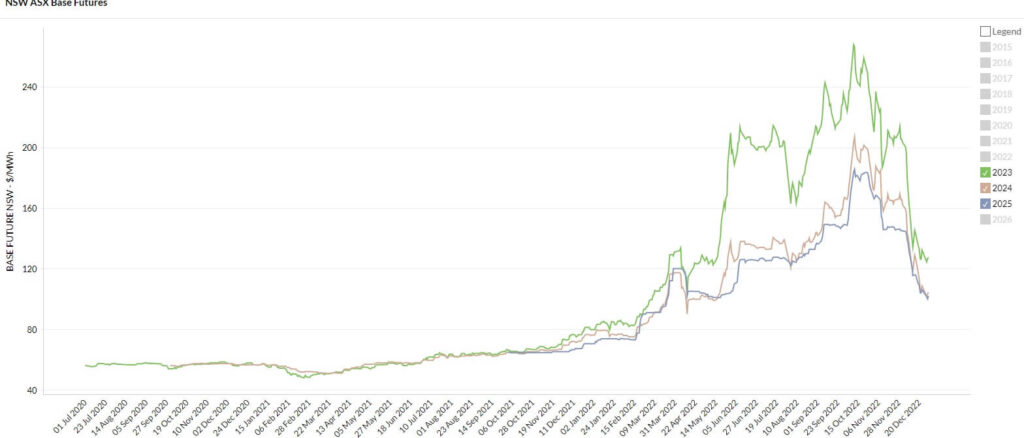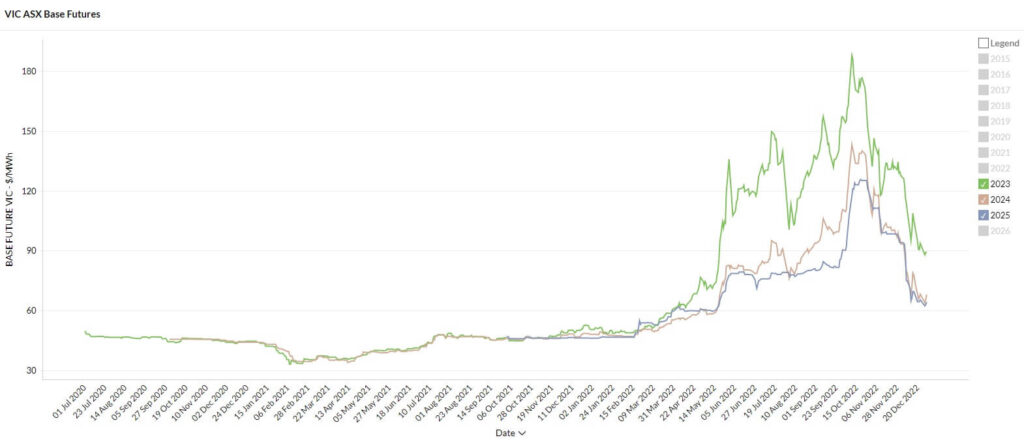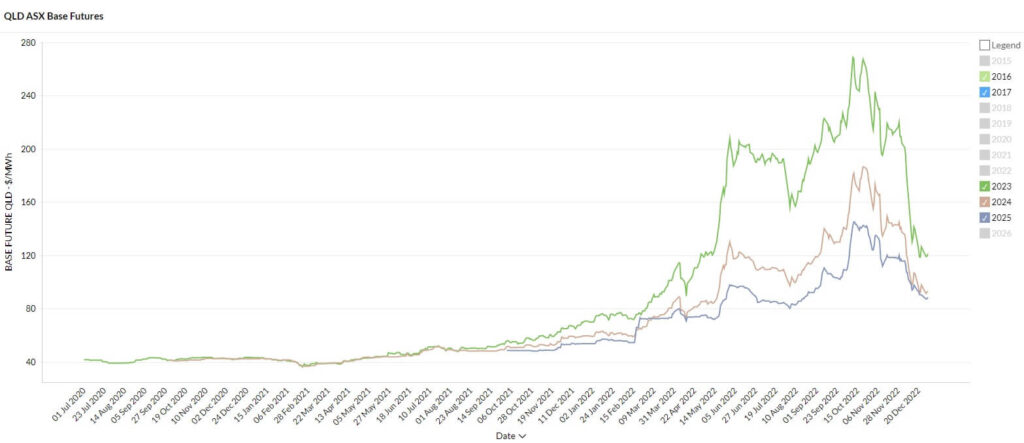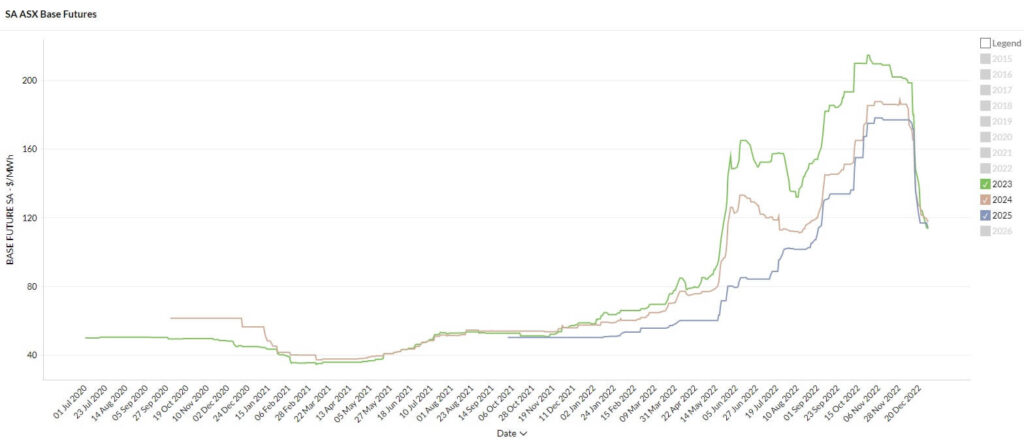For our December 2022 electricity market review, we can report that wholesale electricity futures and spot prices have plummeted since gas and coal price capping legislation was passed in the Federal and state parliaments of NSW and QLD. However, on average, they are still double what they were this time last year.
Following Government budget projections that electricity and gas prices were expected to shoot up by 56 and 40 percent respectively, the Federal Government put a $12/Gigajoule cap on domestic uncontracted gas for 12 months.
The Federal Government hit back at criticism by gas producers, saying that gas was fetching similar prices last year and producers were still reaping handsome profits.
The NSW and QLD state governments also imposed a $125/tonne cap on coal.
The effect on the market was immediate and wholesale prices for 2023, 2024, and 2025 immediately dropped sharply by about 25 percent by 15 December.
The slide continued to the end of the month with prices dropping to almost half the levels they were at during the peak of the crisis in October 2022.
Similarly, electricity spot prices dropped by between 25 and 30 percent and South Australia’s spot prices dropped by almost half.
It is essential to take this news into context. The current market prices (after the sharp drop) are still roughly double the price of December 2021.
In other news, the Federal and NSW Governments announced joint funding of $7.8 billion for Renewable Energy Zones in New South Wales.
The output of large-scale solar farms set a new record of 5,247MW, or 5.25GW in late November, and was a big leap from the previous instantaneous peak of 4,934MW set a couple of weeks earlier.
A multitude of battery storage projects has also been announced around the country. Despite the huge amount of new coverage they get, it is worth noting that fast-discharge batteries only contribute to 0.09% of generation across the NEM. For comparison, pumped hydro contributes 6% and gas 3%.
We realise that this is concerning for businesses. If your business needs help comparing electricity and gas plans, reach out to our energy experts now to lock in a strategy for the summer.
Read more to learn about the electricity market in December 2022.
New South Wales

Average Movement Summary:
| Avg Rate Movement Since: | 1-Jan-2023 | 1-Dec-2022 | 1-Nov-2022 | 1-Aug-2022 | 1-Feb-2022 | 1-Feb-2021 |
| NSW – Average | ⇧ 6.94% | ⇩ 30.25% | ⇩ 35.69% | ⇩ 22.12% | ⇧ 50.12% | ⇧ 121.72% |
- 2023 futures started the month at $205/MWh, but after the news of the Federal Government’s domestic gas cap, prices dropped drastically to $145/MWh by the middle of the month and dropped further to $127/MWh to close off 2022.
- 2023 prices are down $140 from the peak of the crisis in October, but still much more expensive than at the end of 2021, when prices were $80/MWh
- 2024 contracts followed the same trend starting the month at the lower price of $166/MWh, dropping to $129/MWh by the middle of December and closing off the month at $104.
- 2025 contracts started the month at $145, dropping sharply to $116 and again at the end of the month, closing at $102.
Commentary:
- Spot prices dropped significantly in December with the volume-weighted average price (VWAP) at $83/MWh compared to $113 /MWh the previous month.
- Electricity spot prices ranged from -$120/ MWh to a high market cap of $15,500/MWh, suggesting some volatility. There were only three instances where prices were above $400 but there were numerous negative pricing incidents.
- Renewables contributed 40% of the state’s energy, up from 39% the previous month. Reliance on gas was even lower than last month at 0.6%. Coal contribution dropped by around 1% to 50%.
- Federal Labor and the New South Wales Coalition governments committed $7.8 billion to fund eight critical electricity transmission and renewable energy zone projects in the state, including new transmission lines for Snowy 2.0.
- The Federal Government’s announcement of a domestic gas cap and a likely coal cap by the state government was the leading driver in pushing prices down.
Victoria

Average Movement Summary:
| Avg Rate Movement Since: | 1-Jan-2023 | 1-Dec-2022 | 1-Nov-2022 | 1-Aug-2022 | 1-Feb-2022 | 1-Feb-2021 |
| VIC – Average | ⇧ 11.16% | ⇩ 22.85% | ⇩ 32.47% | ⇩ 18.31% | ⇧ 70.88% | ⇧ 116.61% |
- 2023 started the month at $129/MWh, prices tumbled to $109/MWh and then dropped again to $89/MWh to close off the month.
- At $89/MWh 2023 futures are $99/MWh cheaper than at the peak of the crisis in October when they tipped $188 but still significantly more expensive than at the end of December 2021 when they were $50/MWh.
- 2024 contracts started the month at $96, dropping to $79 by the middle of December and closing off the year at $68.
- 2025 contracts started the month at $94 dropping to $69, and closing off the month at 64/MWh.
Commentary:
- The spot market dropped by almost half, with the volume-weighted average price (VWAP) coming in at $31 / MWh compared to $59/ MWh the previous month.
- The spot price was less volatile in Victoria compared to the previous month, spanning between -$937 and a high of $316. There were five instances where negative pricing was between -$400 and -$937.
- Coal generated 60% of the energy mix, up 3% from the previous month. Renewables supplied the state with 39 % of its power, down from 42.5%. Reliance on gas was very low at 0.5% of supply.
- AGL’s Loy Yang A returned to service in the fourth week of October after months of being offline and the uptick in coal-fired energy is attributed to this.
- A new minimum operational demand record of 2,195 MW was set on Monday 19 December at 1 pm, dropping 3.9% from the previous set in October 2022 (2,285 MW). At the time, rooftop solar contributed 55% of underlying demand.
Queensland

Average Movement Summary:
| Avg Rate Movement Since: | 1-Jan-2023 | 1-Dec-2022 | 1-Nov-2022 | 1-Aug-2022 | 1-Feb-2022 | 1-Feb-2021 |
| QLD – Average | ⇧ 6.28% | ⇩ 28.70% | ⇩ 34.17% | ⇩ 9.90% | ⇧ 65.18% | ⇧ 173.32% |
- 2023 started the month at $ 209/MWh. Similar to NSW and VIC, prices dropped sharply to $141/MWh by the middle of the month, closing at $121/MWh.
- 2023 futures were significantly cheaper than at the height of the crisis when they hit $268/MWh but are still much higher than this time last year when they traded at $69/MWh.
- 2024 contracts started the month at $140/MWh, dropping to $107 by the middle of the month and closing the month at $93/MWh.
- 2025 contracts started the month at $117/MWh dropping to 97 and closing the year at $88/MWh.
Commentary:
- Spot prices dropped significantly with the VWAP falling to $86 / MWh from $122 / MWh the previous month.
- Prices were relatively stable, ranging between -$122 / MWh and $1,250 / MWh and only three instances of pricing above $1,000/MWh.
- Renewables supplied 29% of the state’s energy for the month, on par with November. The majority came from solar (24%). Coal supplied 65 % of demand and gas was down by 1% to 6%.
- CS Energy’s 750 MW coal-fired Kogan Creek generator returned to service on 21 December. News from Callide C is not so great. The replacement parts for C4 have arrived in Australia but are delayed in Gladstone. The generator is not expected to be active until May 2023, with month-by-month increments to generator capacity. C3, which suffered structural failure is also set to return in May in an incremental manner.
South Australia

Average Movement Summary:
| Avg Rate Movement Since: | 1-Jan-2023 | 1-Dec-2022 | 1-Nov-2022 | 1-Aug-2022 | 1-Feb-2022 | 1-Feb-2021 |
| SA – Average | ⇧ 0.00% | ⇩ 38.53% | ⇩ 38.88% | ⇩ 3.38% | ⇧ 95.89% | ⇧ 184.81% |
- 2023 Futures prices in SA also dropped significantly, but not as much in other states. Prices at the start of December hit $202/MWh before dropping to $159/MWh and closing the month at $113/MWh.
- 2023 SA futures traded at $207/MWh at the height of the crisis, but are still significantly higher than at the end of December 2021 when they fetched $58/MWh on the market.
- 2024 contracts started the month at $186/MWh and dropped to $147/MWh by the middle of the month and closing at $117/MWh.
- 2025 contracts opened at $177 dropped to $150 by mid-December and closed the year at $115.
Commentary:
- Average spot pricing dropped by almost half with the VWAP falling substantially to $36 / MWh from $63 / MWh the previous month.
- Volatility was high with a high of $12,523/MWh and almost 3,000 incidents of negative pricing due to an abundance of renewables. The lowest price was $-1000.
- Renewables generated a staggering 86% of the state’s energy mix. Wind power accounted for 50% of total generation and solar 36%. Gas generation at 13.5% was the highest in the NEM.
- SA was supplied by 100 percent renewable energy for 10 days and 9 hours (a total of 249 hours) between 8:20 am on Friday, December 9, to 5.20 pm Monday, December 19. Rooftop solar contributed 26.3 per cent – and dominated daytime production, sometimes up to 92 percent of local demand.
There is no doubt that Federal Government intervention in the gas market and state intervention in the coal market has driven down electricity prices in all NEM states.
Whether that trend continues remains to be seen but the response in terms of pricing has been encouraging.
Pricing on the international market will continue to be dominated by the war in Ukraine and whether or not a new Russian offensive is mounted in the Northern Hemisphere Spring.
Depending on risk appetite, now could be a good time for businesses to purchase electricity through wholesale tenders.
We hope our December 2022 electricity market review has proven informative and insightful. For more context on the situation in the energy market for the previous months, you may find our monthly energy market reviews here. Reach out to our energy experts to understand your options in these difficult conditions.
Explainer: Why we focus on Wholesale Futures Prices
Wholesale Futures Price: Wholesale futures prices are based on expectations of average future spot prices. If supply is expected to be tighter in the future, this will raise contract prices. The offers that commercial and industrial customers receive from Leading Edge Energy are wholesale futures prices reflected in kWh rather than MWh.
Spot Price: This represents how much the spot market is charging for electricity currently based on demand and supply. Spot prices go up when demand is high and supply is tight. You can view live Spot Prices here
Disclaimer: The information in this communication is for general information purposes only. It is not intended as financial or investment advice and should not be interpreted or relied upon as such.
Interested in getting personalised energy efficiency and cost reduction advice for your business? Your People in Power are ready to help
Get Started Here













